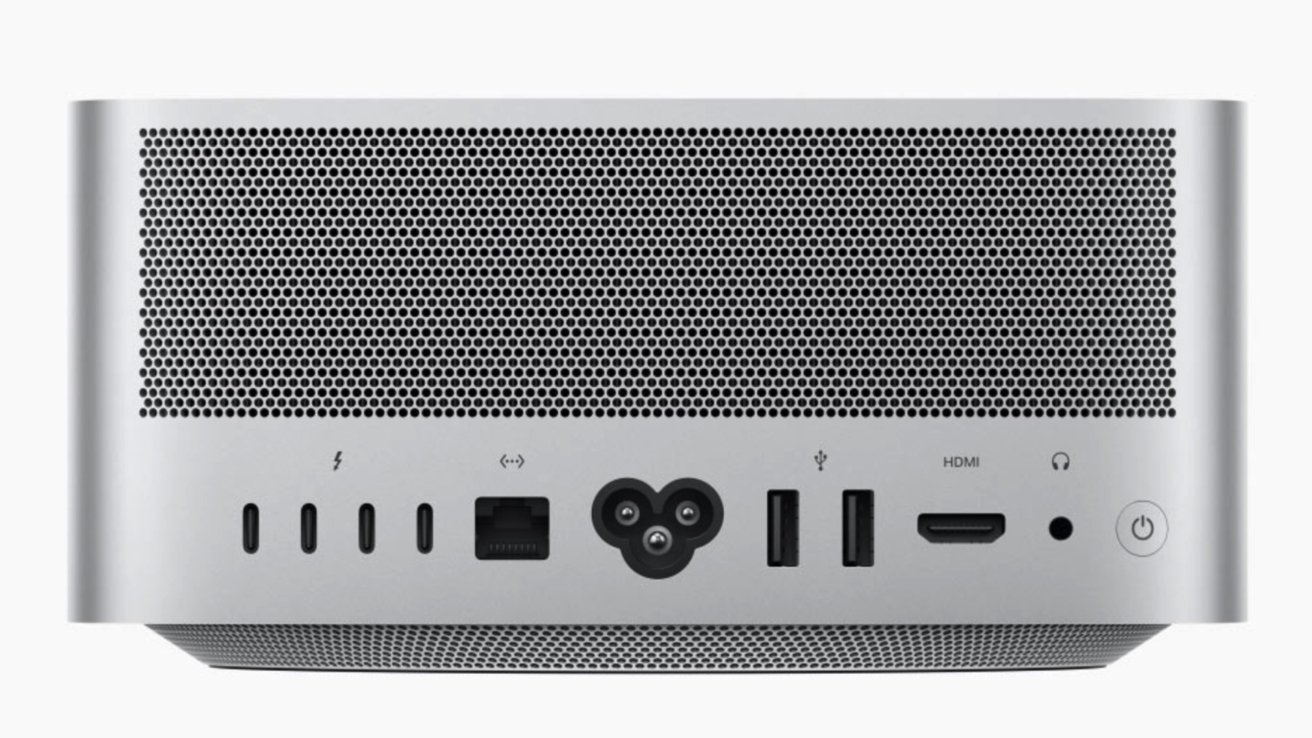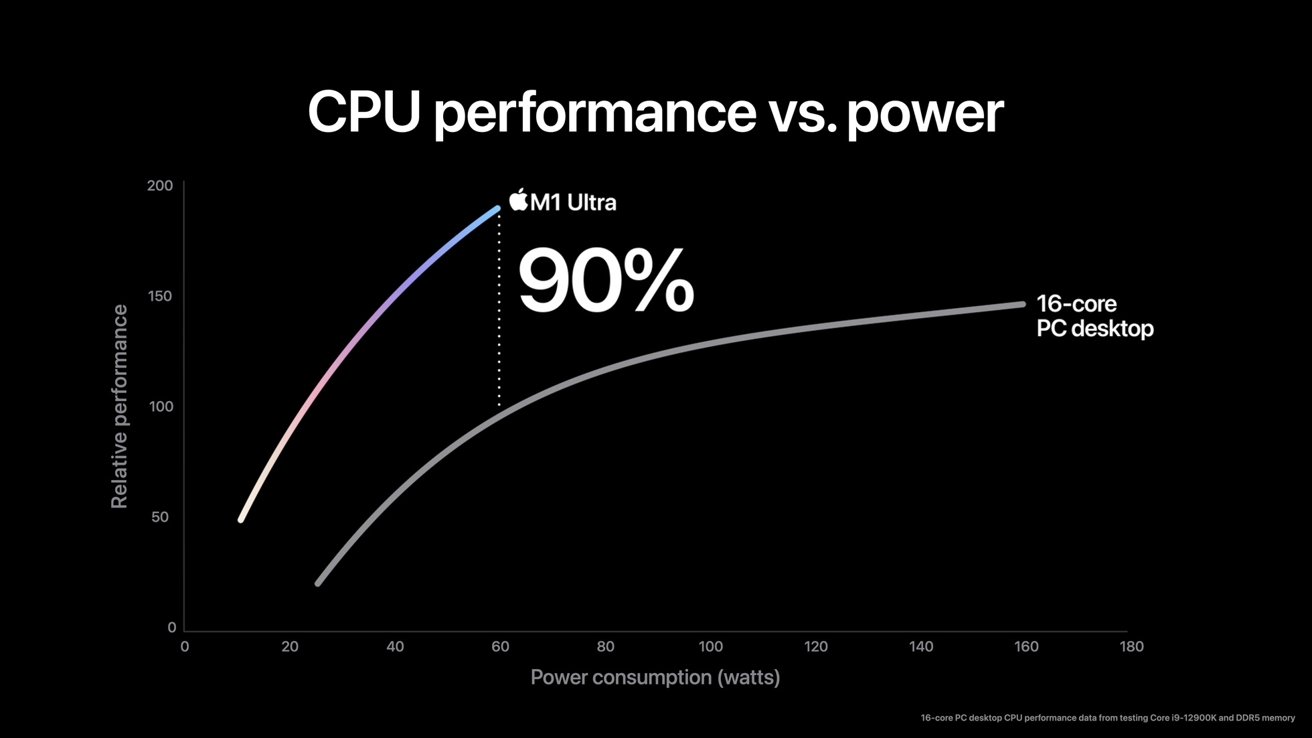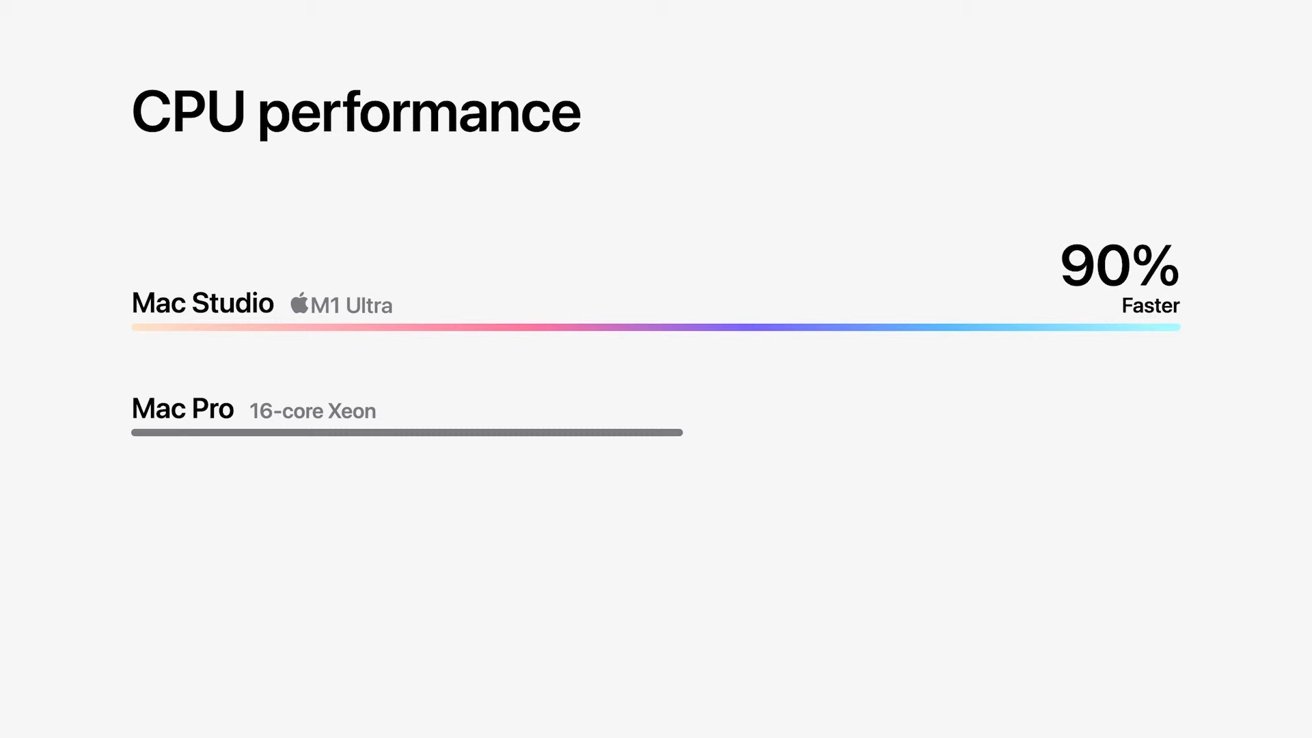Fully loaded Mac Studio costs just $7999, more powerful than similarly priced Mac Pro
A fully loaded Mac Studio with an M1 Ultra chip runs $7,999, significantly less expensive than a maxed-out Mac Pro was at release -- and notably more powerful.

On Tuesday, Apple took the wraps off of its Mac Studio, an all-new Mac with an all-new form factor that includes the company's most powerful chip yet -- the M1 Ultra.
According to Apple's benchmarks, the M1 Ultra is up to 90% faster than the speediest 16-core PC desktop chip and provides better graphics performance while using much less power.
A maxed-out Mac Studio with a 20-core CPU, 64-core GPU, 32-core Neural Engine, 128GB of Unified Memory, and an 8TB SSD retails for $7,999.
For users who need a bit less power, a fully loaded M1 Max Mac Studio equipped with the same SSD and memory costs $4,999.
That's much cheaper than a fully loaded Mac Pro was at its release. A user who wanted the top specifications on the desktop Mac Pro would shell out $53,000. The iMac Pro, Apple's most powerful Mac before the Mac Pro was released, retailed for more than $17,000 with top-tier specs.
However, unlike the Mac Pro and iMac Pro, the Mac Studio doesn't come with any peripherals. Users who wish to add in at least a Magic Keyboard and Mouse can expect to pay an extra $300 if they want the silver-and-black accessories. Of course, they could also just use their existing setup.
While the iMac Pro had a built-in display, the maxed-out Mac Pro's $53,000 price tag didn't include a display. That's similar to the Mac Studio. However, the Apple Studio Display, which is designed to complement the Mac Studio, costs $1,599 -- a lot cheaper than the pricier Pro Display XDR.

Mac Studio CPU comparison
The Mac Studio with an M1 Max chip is up to 50% faster than a 16-core Mac Pro. A Mac Studio model equipped with Apple's new M1 Ultra is up to 90% faster than the 16-core Mac Pro, and up to 60% faster than a 28-core Mac Pro.
Apple's event benchmarks are, of course, weighted in the company's favor. Still, the gains go to show just how significant Apple's performance gains have been with Apple Silicon -- and how it can pass on the savings of using in-house chips to its customers.

Mac Studio versus Mac Pro CPU comparison
It's also interesting because it might hint at what Apple has in store for its next Mac Pro refresh -- the last device in Apple's Mac lineup to get the Apple Silicon treatment. Although we don't know how much it will cost, we can assume that it'll be more powerful than the Mac Studio.
For the best deals on every configuration, be sure to visit our Mac Studio Price Guide.
Read on AppleInsider

On Tuesday, Apple took the wraps off of its Mac Studio, an all-new Mac with an all-new form factor that includes the company's most powerful chip yet -- the M1 Ultra.
According to Apple's benchmarks, the M1 Ultra is up to 90% faster than the speediest 16-core PC desktop chip and provides better graphics performance while using much less power.
Comparing the Mac Studio's pricing to the Mac Pro
Despite the massive bump in performance versus the Mac Pro, the Mac Studio hasn't seen a significant bump in price.A maxed-out Mac Studio with a 20-core CPU, 64-core GPU, 32-core Neural Engine, 128GB of Unified Memory, and an 8TB SSD retails for $7,999.
For users who need a bit less power, a fully loaded M1 Max Mac Studio equipped with the same SSD and memory costs $4,999.
That's much cheaper than a fully loaded Mac Pro was at its release. A user who wanted the top specifications on the desktop Mac Pro would shell out $53,000. The iMac Pro, Apple's most powerful Mac before the Mac Pro was released, retailed for more than $17,000 with top-tier specs.
However, unlike the Mac Pro and iMac Pro, the Mac Studio doesn't come with any peripherals. Users who wish to add in at least a Magic Keyboard and Mouse can expect to pay an extra $300 if they want the silver-and-black accessories. Of course, they could also just use their existing setup.
While the iMac Pro had a built-in display, the maxed-out Mac Pro's $53,000 price tag didn't include a display. That's similar to the Mac Studio. However, the Apple Studio Display, which is designed to complement the Mac Studio, costs $1,599 -- a lot cheaper than the pricier Pro Display XDR.
A hint at things to come
Although stacking the Mac Pro against the Mac Studio isn't a perfect one-to-one comparison, it helps to put the latter device in context. That's especially true when you account for performance gains.
Mac Studio CPU comparison
The Mac Studio with an M1 Max chip is up to 50% faster than a 16-core Mac Pro. A Mac Studio model equipped with Apple's new M1 Ultra is up to 90% faster than the 16-core Mac Pro, and up to 60% faster than a 28-core Mac Pro.
Apple's event benchmarks are, of course, weighted in the company's favor. Still, the gains go to show just how significant Apple's performance gains have been with Apple Silicon -- and how it can pass on the savings of using in-house chips to its customers.

Mac Studio versus Mac Pro CPU comparison
It's also interesting because it might hint at what Apple has in store for its next Mac Pro refresh -- the last device in Apple's Mac lineup to get the Apple Silicon treatment. Although we don't know how much it will cost, we can assume that it'll be more powerful than the Mac Studio.
For the best deals on every configuration, be sure to visit our Mac Studio Price Guide.
Read on AppleInsider


Comments
As for the fully loaded Studio for $7999, that's actually an amazing price for what you're getting. Sflocal is correct, try and build a desktop using Intel, AMD or ARM and you'll have to spend several times this amount. Try and build one that fits into 219 cubic inches and you'll never do it. The cooling system would take twice that amount of space and it still wouldn't be able to cool an over-clocked CPU. It also wouldn't be able to process anything at the speed of the M1 Ultra. Professionals don't have to wait for a Mac Pro replacement, it's already here. Just add external storage arrays (a nice NVMe RAID over Thunderbolt 3) and a 10Gb network switch with access to your servers and you won't have a second to nap because almost everything is happening real time.
New Tesla Model Y, costs just $7999
Yeah, that would be meaningful in my view.
That is going to be the sticking point, for me, and if you're truly doing an honest to goodness cost assessment, the lifespan of the machine and future modular upgradeability has to be factored in.
Another factor should also be repairability. The Mac Studios don't even have user replaceable power supplies, like the Intel Minis did.
That's absolutely insane, especially if you're getting the maxed out model.
A PSU is a $150 part, and while it is rare, they can die, and having a $150 part be the absolute death of a $8000 computer is just mind bogglingly stupid.
Regarding the lack of upgradeability. As has been said thousands of times before on this forum and elsewhere, the vast majority of Apple users do not want to be bothered with upgrading their Macs. It's just not a big enough use case. The few people who do, are not Apple's target market, and the rest of Apple's customers are grateful that Apple will not compromise all the other benefits that come with packaging everything into the chip, etc., for the sake of the tinkerers. One of the primary reasons for the extraordinary performance of these machines, compared with Intel machines, is that packaging.
If you want to upgrade your Mac, here's what you do:
That's the process. That's how you upgrade a Mac. Just because the process is different (to upgrading a PC by pulling one part at a time out and putting replacement parts in) doesn't invalidate said process. In fact the reverse is true. Macs are not PCs. PCs are a collection of parts that more or less work together. Macs are complete optimized black box units that work extremely well (including the OS) because of all the integration.
Most Mac users prefer Macs BECAUSE of those points, not despite them. For anyone who disagrees -- who considers those points to be negatives rather than positives -- then the question is: "If it defies your particular needs, preferences, desires, etc., then why do you want a Mac?"
Still, drop storage back to 2Tb and GPU cores back to 48 and that price drops to 2/3s or you need the space but your apps won't get value from the ultra a fully loaded Max is $4,999.
these are pro machines you buy what gets the invoices paid.